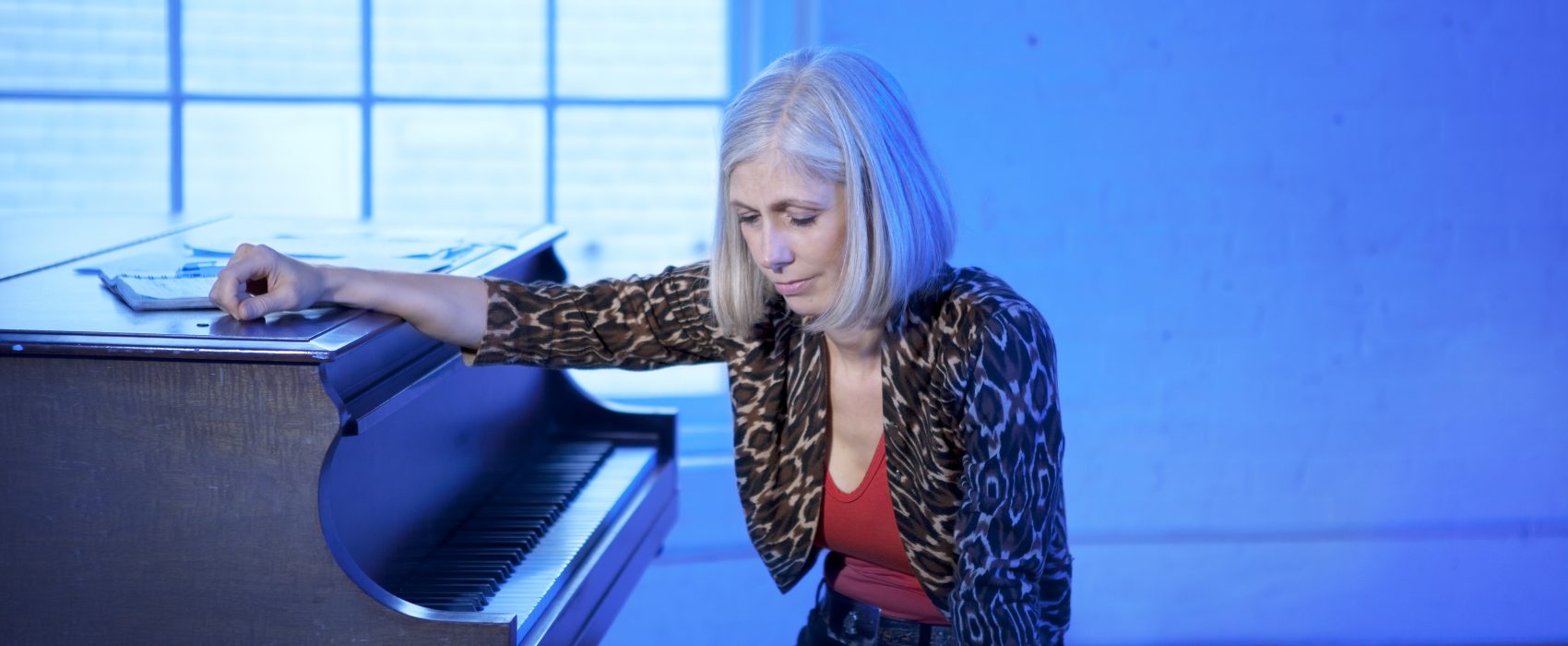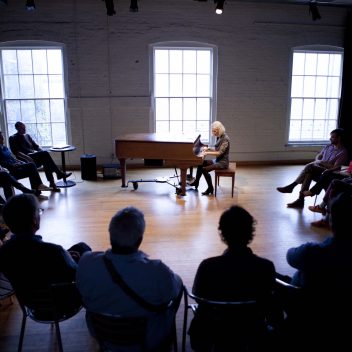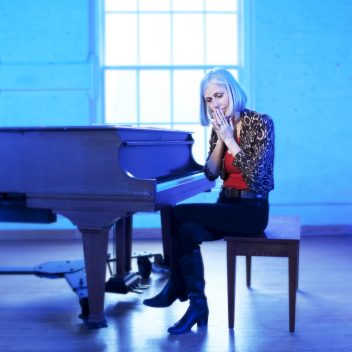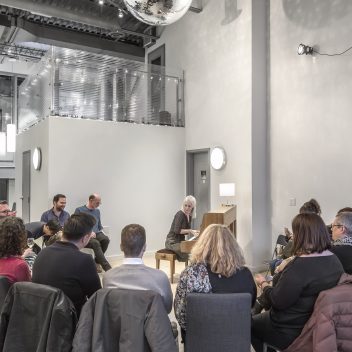
Image: Jane Miller (Max Telzerow)
These Are The Songs That I Sing When I’m Sad
book ticketsBy Jane Miller and Brian Quirt
These Are The Songs That I Sing When I’m Sad is an intimate and joyous performance for one singer and an audience gathered around her piano. It explores the songs people turn to when they’re sad, the songs that they play to soothe their blues or lift them up out of the depths. Jane sings and tells stories about songs that play this role in her own life, and then invites the audience to share the songs that they sing (or play or listen to) when they’re sad. It’s a rare opportunity to hear a superb singer up close and personal as she delves into the link between deep emotions and the musical elements that make sad songs so addictive.
After each performance we publish a playlist of sad songs mentioned during the show. Check out the most recent playlist below, or use the production history to access previous playlists from cities we’ve toured to since 2020.
Playlists
ArtSpring, Salt Spring Island, BC
Saturday February 24, 2024, 7:30 pm
ArtSpring, Salt Spring Island, BC
Friday February 23, 2024, 7:30 pm
ArtSpring, Salt Spring Island, BC
Thursday February 22, 2024, 7:30 pm
ArtSpring, Salt Spring Island, BC
Wednesday February 21, 2024, 7:30 pm
ArtSpring, Salt Spring Island, BC
Tuesday February 20, 2024, 7:30 pm
Production History
Premiere Production
These Are The Songs That I Sing When I’m Sad
Produced by Nightswimming
Presented by Boca Del Lupo, Vancouver
June 7 – 10, 2017
Created by Jane Miller and Brian Quirt
Performed by Jane Miller
Dramaturged and directed by Brian Quirt
Produced by Brittany Ryan
Designed by Rebecca Picherack
These Are The Songs That I Sing When I’m Sad was commissioned and developed by Nightswimming. Thank you to Tapestry Opera for developmental support, and to Leslie Haller, Rupal Shah, and the many audience members who contribute their stories.
Touring
2016
Nightswimming, Toronto, Ontario
2017
Boca Del Lupo, Vancouver, British Columbia
2018
Boca Del Lupo, Vancouver, British Columbia
Blyth Festival, Blyth, Ontario
2020
Talk Is Free Theatre, Barrie, Ontario
Online version via Zoom
2022
Ryga Arts Festival, Summerland, British Columbia
2023
Tarragon Theatre, Toronto, Ontario
Belfry Theatre, Victoria, British Columbia
2024
ArtSpring, Salt Spring Island, British Columbia
Yukon Arts Centre, Whitehorse, Yukon Territory
*NOTE: playlists for each city can be accessed by the link to the tour stop
Dramaturgy and process
The idea for Sad Songs came to Brian when he was driving…the title popped into his mind as he was contemplating our attraction (and his own) to sorrowful songs. Having worked many times with Jane Miller on Nightswimming projects such as Lake Nora Arms and The Death of General Wolfe (and more recently The Wolf in the Voice), Brian approached her with the title and the idea of exploring that attraction in a new piece. Jane & Brian discussed their fascination with the songs that they and others repeatedly return to, many with melancholy content (such breakup songs), as well as songs that we reach for that are joyful or beautiful or triumphant.
This project continues my investigation into the theatricality of the human voice that began with Blue Note and continued with Why We Are Here!, but in a much more individual and intimate way that aligns with my growing interest in projects that incorporate the audience into the performance.
Jane went away to think about Brian’s prompt, and returned with a series of songs and stories from her own life which now form the spine of the show, alongside research into the science and musicology of sad music. This research evolved in the studio into exploring the physiological reasons we are attracted to certain musical elements, and ways to illustrate this material quickly and entertainingly to an audience. As with Broken Tailbone, the piece was created via improvisation, without writing down the text, so that it could remain spontaneous. By having Jane repeatedly tell the stories, we honed word choices, structure and content without consciously setting anything, allowing the storytelling to slowly take form, to become a score for the show, which offered Jane the freedom to connect to and improvise with the audience as she performed.
Building further on the ideas explored in other Nightswimming works that integrate the audience, we wanted to invite the audience to join the conversation. During the show, Jane asks them to share, if they wish (and they always do), their own favourite sad songs. More importantly, Jane then draws out the beautiful, moving, often hilarious stories behind these songs, illuminating the events that create this unbreakable bond of singer, song and emotion. The audience conversation takes almost half of the performance, before Jane resumes her own stories and brings the show to a close by inviting everyone to join her in song. Ultimately, our dramaturgical goal was to offer audience members a fresh perspective on sad songs – their own and others – and a need to listen them anew.
Nightswimming’s 2016 workshop production in Toronto invited designer Rebecca Picherack into the process. With her input we defined more fully the relationship between Jane and the audience, and Rebecca contributed a simple yet beautiful lighting design in which the audience is fully lit until the end of the show, since they are participants, not only spectators.
To learn more about the world of Sad Songs, visit sadsongs.ca, which includes playlists of all of the songs mentioned by audience members during our performances. This micro-website was part of a five year initiative in which Nightswimming – with the generous support of the George Cedric Metcalf Foundation – created show specific sites that complement and expand the audience experience of each show.
During the pandemic, Brian and Jane created an online version using the ubiquitous Zoom platform to bring Sad Songs directly into audience members’ homes. This worked beautifully, though we were pleased in 2022 to resume in-person touring with a run at the Ryga Arts Festival in Summerland, British Columbia.
We’re happy to add that the show continues to evolve. In January 2023 we partnered with the Tarragon Theatre’s inaugural Greenhouse Festival to create a version of Sad Songs for an audience of 100 in the Tarragon Extraspace theatre. Though this version seems a little less intimate than the version we have performed for 15 to 25 people, we were delighted to find that audience engagement was just as strong. Dozens of sad songs and the stories behind them were shared during the performance.
As a result, we now offer two versions of the show: the original for 15-25 audience members set up in a circle – a version that is also available for shows in private homes and alternative spaces; and a version for audiences of up to 100 in proscenium theatre. Touring will continue in 2023-24!
Sad Songs is available for touring; please contact Nightswimming Producer
Gloria Mok for more details at: gloria@nightswimmingtheatre.com.
This is the perfect show for these times when we are sad about the world, what we can and cannot do because of the pandemic. Jane Miller is a really gifted singer-song-writer-performer-musician….and the show is a joyous look at how music gets us through those sad times and why we hold them close to us.
Lynn Slotkin
Miller is so animated – leaping off her stool with air-drums rolls – and she allows herself to be so completely vulnerable that it’s impossible not to be drawn in. At times, it’s almost unbearably intimate. When the audience is asked to reveal – with or without context – songs that make them sad, it would not be surprising to see tears.
Vancouver Theatre Reviews
Miller’s presentation of this information is so casual that it never feels like a lecture; it’s more like good dinner-party conversation. She encourages the audience to share their favourite sad songs, and there’s an uncensored quality to the group’s reactions—which include a good deal of laughter—to her stories.
Georgia Straight
With equal parts performance, concert, round-table discussion and musical master class, Miller takes audience members on an emotional and musical journey unlike any they’ve been on before. Open and vulnerable with the audience, Miller touches on the sad times in her life and how she connected with specific pieces of music during those times. When Miller asks audience members for their sad song choices, it can be heartbreaking as you see fellow audience members wrestle with their own traumatic memories and what that music means to them. Sad Songs isn’t simply a round-table discussion on the effects of sad music. The talented and accomplished Miller is singing throughout the performance and audience members can’t help but feel privileged to hear a performance by such an elegant, beautiful vocalist from just feet away.
North Huron News


